Cake Sand Dollar (Arachnoides placenta)
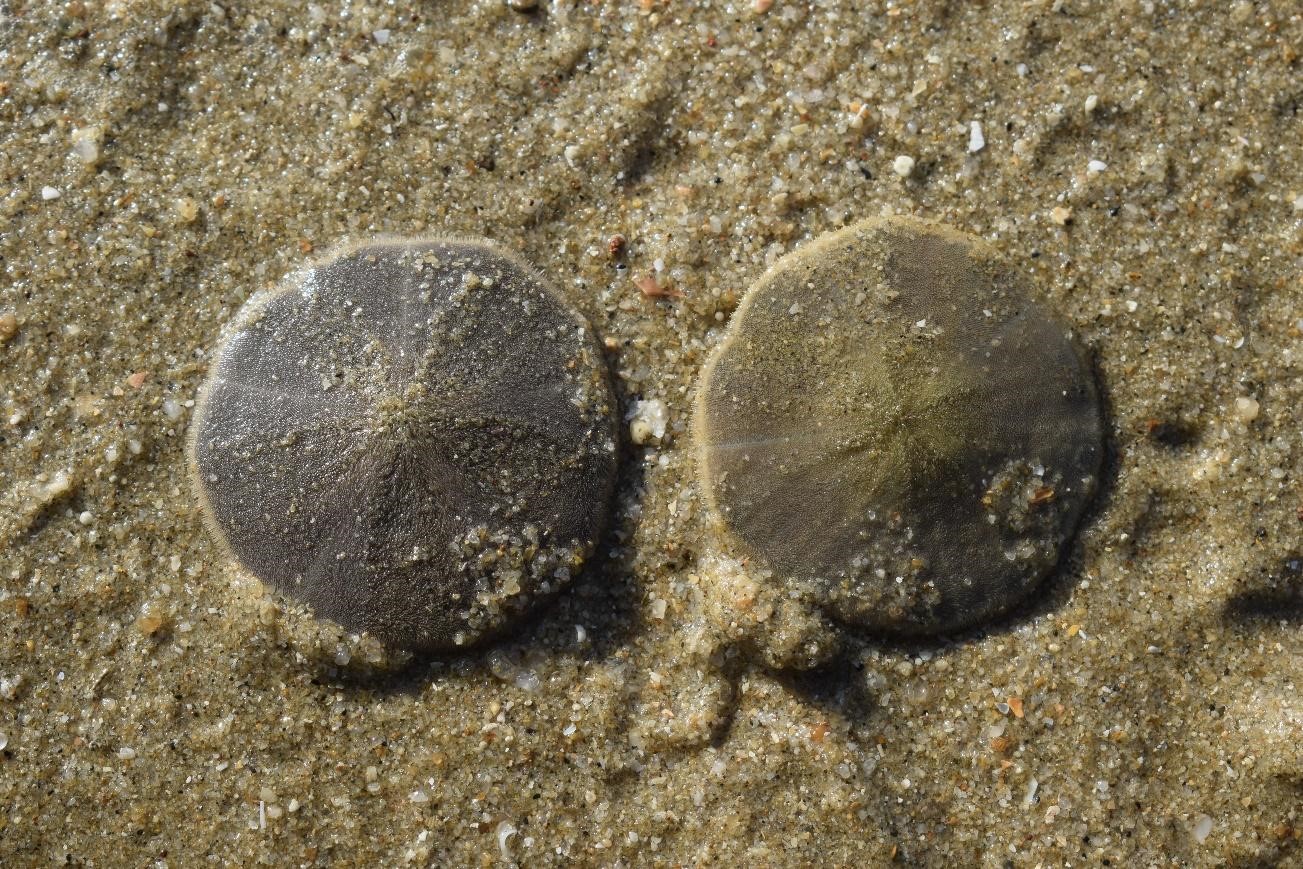 |
| Cake sand dollar on Changi Beach (Image by Hannah Yeo, 2016) |
Overview
Table of Contents
The cake sand dollar is one of the most common sand dollars in Singapore. They can be found in large numbers, half buried under the sand. Oftentimes, you must dig into the sand to find them. It is almost like treasure hunting! For those that have yet to see one, I hope that this page would interest you enough to try out the “treasure” hunting game the next time you visit the beach. It is open to all, just find the next low tide and head over to the beach for some fun! Do note that there are some important rules for this. As we want to be good environmental stewards, do not flip the sand dollars upside down, avoid stepping on them and do not collect them from the beach. Otherwise, have fun and all the best to finding some treasures/sand dollars!
What is a sand dollar?
Sand dollars are not named after their value, but after their appearance. The skeletons (called tests) of dead sand dollars get bleached by the sun and turns white. In the past, people thought that these white skeletons of sand dollars looked like old Spanish or American dollar coins and they called them sand dollars [1].From Urchins to Sand Dollars
Sand dollars are echinoderms, this means that they are related to sea cucumbers, sea stars and sea urchins. As a matter of fact, sand dollars are flattened sea urchins. Typically, we think of sea urchins (regular) as looking something like this.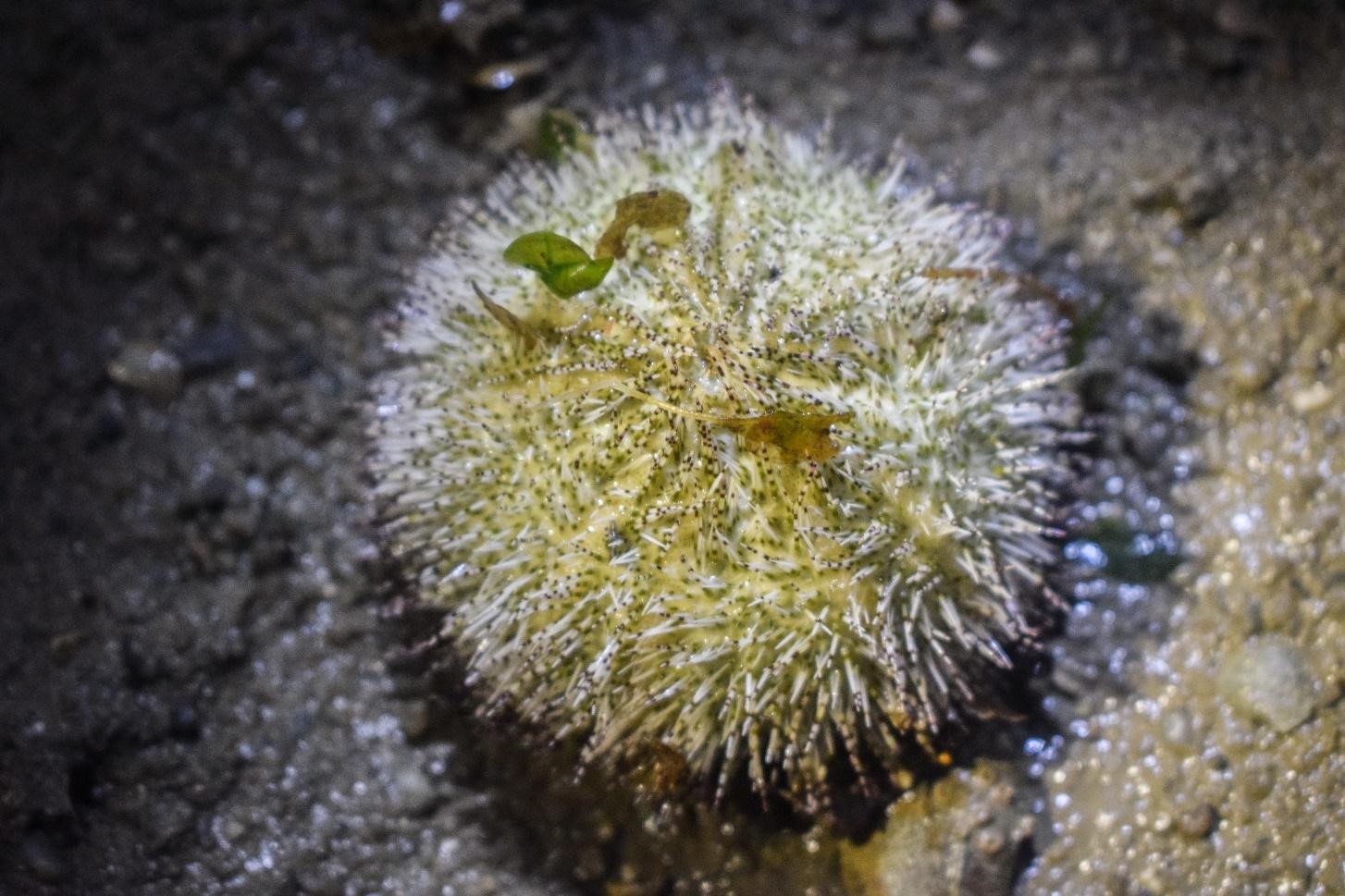 |
| White salmacis urchin (Salmacis sphaeroides) on Changi Beach (Image by Hannah Yeo, 2016) |
In comparison, sand dollars (Clypeasteroids) are irregular and flattened urchins that are adapted for thriving in fine shifting substrate, which was a habitat previously inaccessible to most other urchins [2]. The physical changes from regular sea urchins includes the lfollowing:
1. Flattened body
The body changes from a round (spherical shape) to a flat (disc shape) skeleton like this.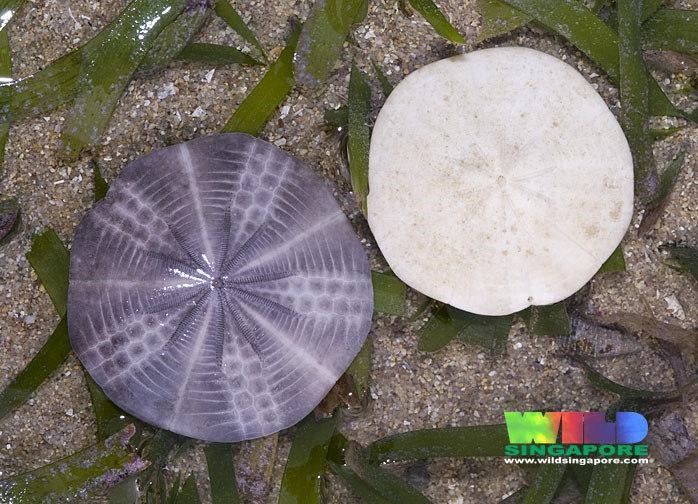 |
| Flat disc like body of the cake sand dollar (Image by Ria Tan, 2009) |
2. Short spines for movement
Spines of regular sea urchins are usually elongated, but the spines in sand dollars are tiny and short, which helps them move or burrow into the sand. This can be seen in the video embedded below.Short spines and burrowing movement of a sand dollar [3]
A distinctive trail is left behind in the sand at low tides and the sand dollar can be found just beneath the surface at the ends of these trails. Look out for these trails the next time you visit the intertidal zone!
 |
| Trails left in the sediment by the cake sand dollars at low tide (Image taken by Hannah Yeo, 2016) |
Unlike sea stars that can contour their flexible bodies to flip themselves over or sea urchins that can make use of tube feet to right themselves [4], sand dollars, with their rigid skeleton and tiny spines, have a much harder task of righting themselves when they are upside down. Overturned sand dollars may take up to half an hour to right themselves. They do it by digging the end of their body into the substrate and basically wait for waves or water flow to flip them back up [5]. This is very hard for them and failure to right itself would often lead to death [4]. Therefore, it is very important to place sand dollars the right way around after handling them (first important rule when you find one on the beach)!
3. Jaw apparatus
The jaw apparatus of sand dollars (called the Aristotle’s lantern) is compressed and modified into a crushing mill.The Aristotle’s lantern in regular urchins are usually thicker and looks like this.
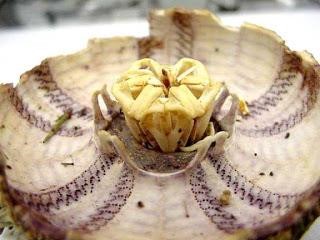 |
| Aristotle’s lantern in regular urchins [6] |
Meanwhile, evolutionary changes from regular urchins modified the lantern into a crushing mill for grinding diatoms and sand grains [7] [2].
Here is a picture showing the Aristotle’s lantern in sand dollars.
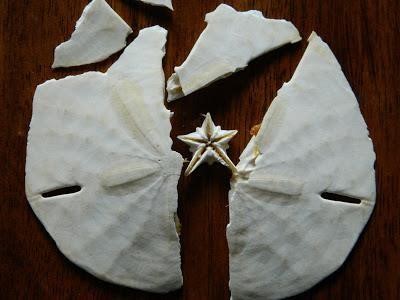 |
| Aristotle’s lantern in a sand dollar [8] (Permission pending) |
Can you spot the five doves? Take a closer look at the photo.
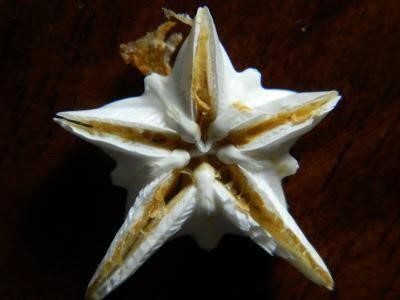 |
| Five kissing doves also known as the Star of Bethlehem [8] (Permission pending) |
If you have ever heard someone talking about the legend of sand dollars, this is what they are referring to. According to the legend, when the skeleton of the sand dollar is cracked open, five small doves of peace from within can be found. It is associated to Christianity whereby the sand dollar is said to represent the birth, crucifixion and resurrection of Jesus [8]. At the heart of the skeleton is the Star of Bethlehem, which actually is the complete Aristotle’s lantern. The five doves that are thought to spread peace are the broken fragments of the lantern.
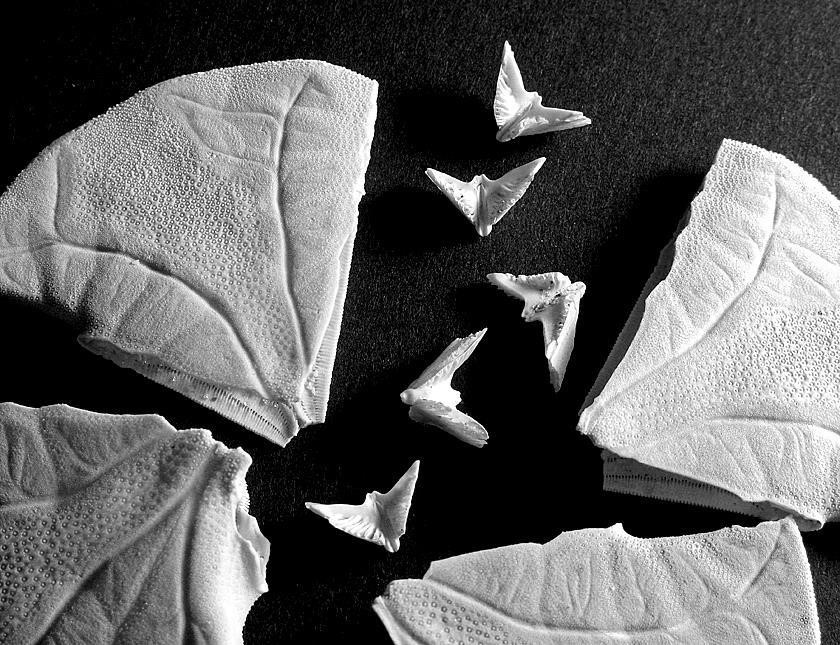 |
| Five doves are broken fragments of the Aristotle’s lantern [9] |
Just Google “the legend of the sand dollars” and you can find crafts or old post cards like this one.
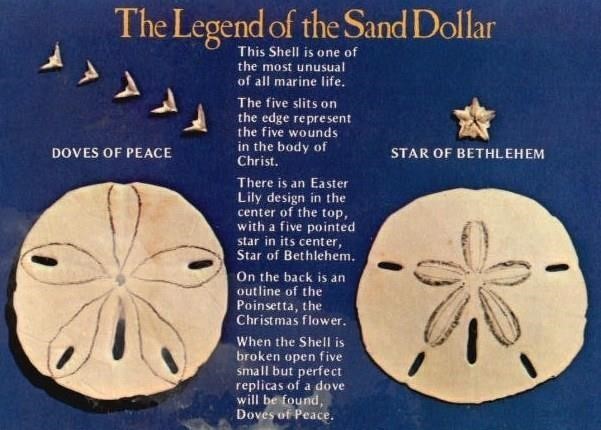 |
| Old post card on the legend of the sand dollar [10] |
The Cake Sand Dollar
Arachnoides is a small genus, containing of only two species. Unlike the other species (Arachnoides tenuis) which is restricted to only the Western Australia [11], the cake sand dollar is widely distributed throughout the Indo-West Pacific region.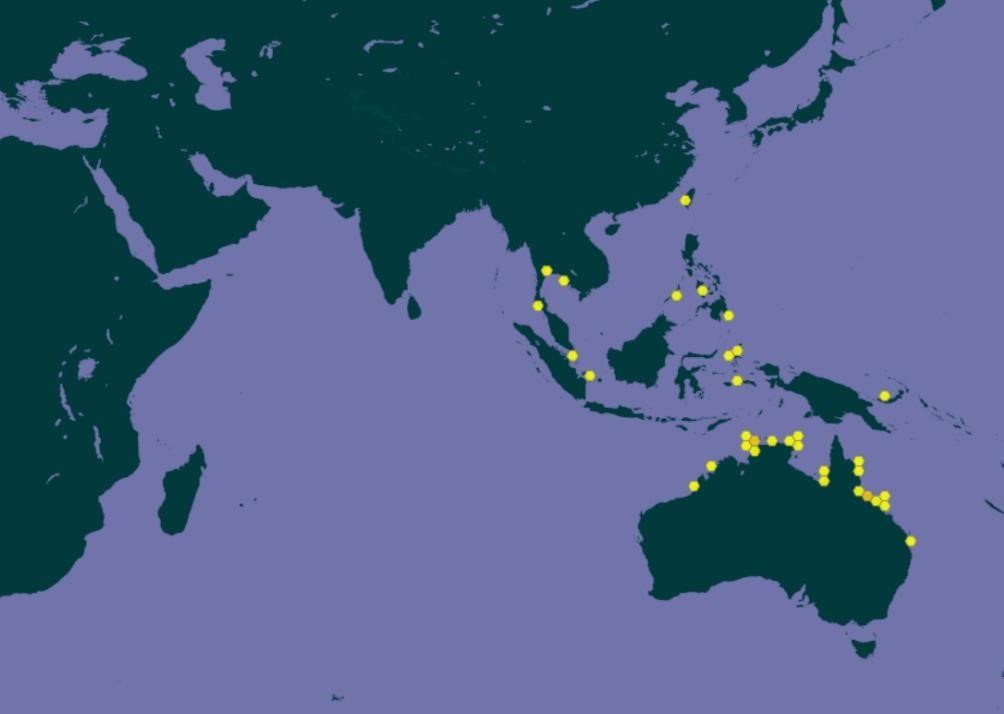 |
| Global distribution of the cake sand dollar (Retrieved from the Global Biodiversity Information Facility [12]) |
Native Distribution
Distribution of the cake sand dollar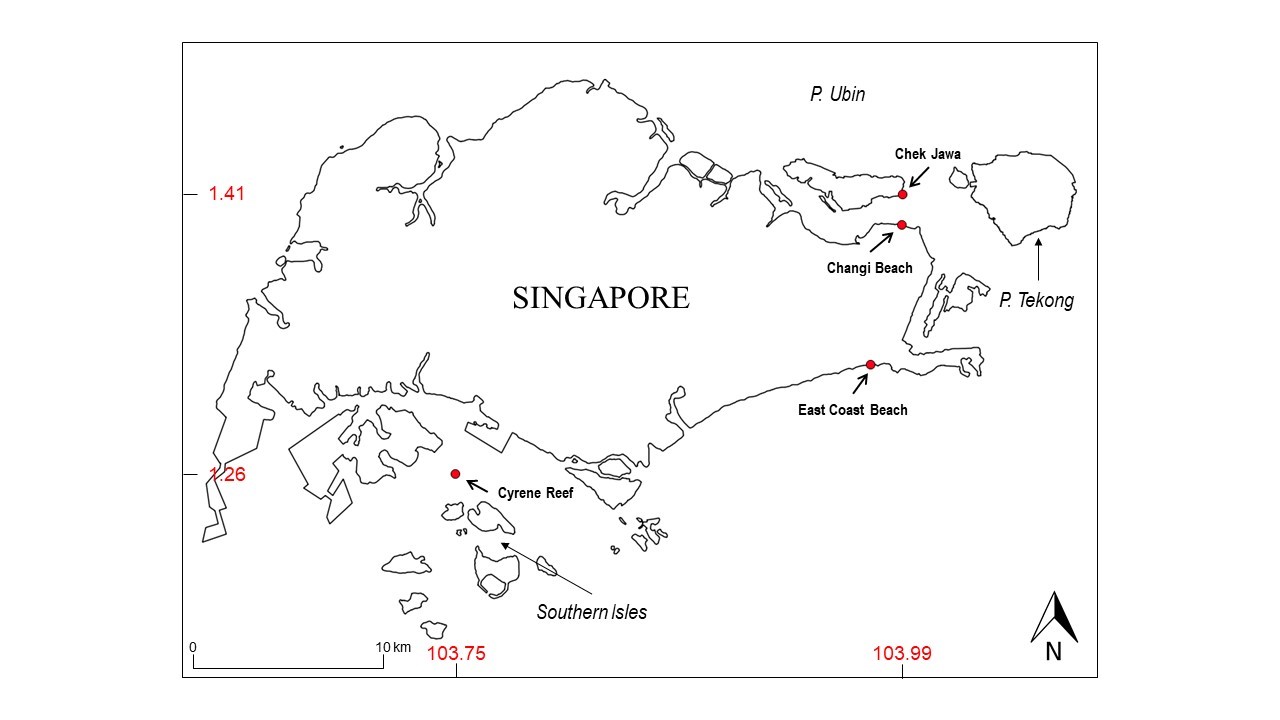 |
| A map displaying the localities in which the cake sand dollar has been recorded. (Map from Global Administrative Areas [13]. Annotations by Hannah) |
The cake sand dollar is commonly seen on our northern shores (i.e. Chek Jawa and Changi), with additional sightings on Southern shores (i.e. East Coast) and Cyrene Reef [14] [12].
Habitats
This sand dollar is found in tropical intertidal sandy habitats [15] and prefers habitats which are permanently damp or wet. When stranded at low tide, they are usually found in pools or ripples containing wet sand [7] [16] [17]. In the absence of such pools, A. placenta responds to reduced moisture within the sediment by burying itself deeper, especially on dry sand bars where individuals have been found at depths of 5cm [18].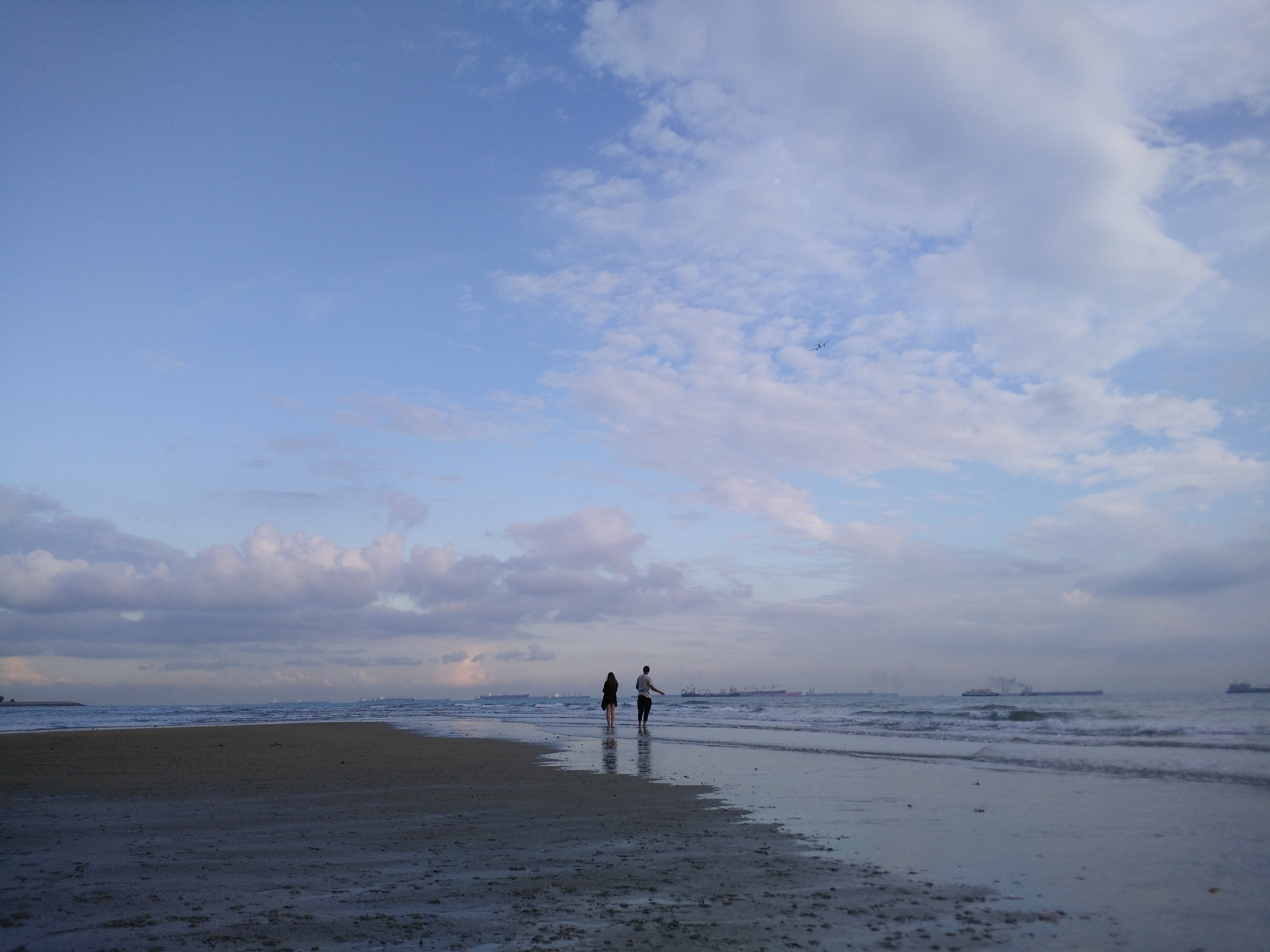 |
| An example of tropical intertidal sandy habitat with high abundance of cake sand dollars. Those small "bumps" on the sand are actually all cake sand dollars! (Image by Hannah Yeo, 2016) |
Its distribution is patchy, and can be superabundant in certain parts of the beach while scarce in others [19]. Adults tend to be more abundant in substrate that contains fine to medium particle size, but can also be found in coarse particle substrata, thus indicating a wide range of tolerance to various particle size [7]. This preference for sediment grain size could be related to the effect that particle size may have on the burrowing and feeding behavior of the species.
Identification and Diagnosis character
The cake sand dollar has an orbicular body with a slightly concave base. There are no slots in the body. Colour ranges from dark purplish-grey, purple to beige [14]. Like most sand dollars, it possesses tiny spines (cilia) that are believed to help ferry food and bury themselves into the sand [20].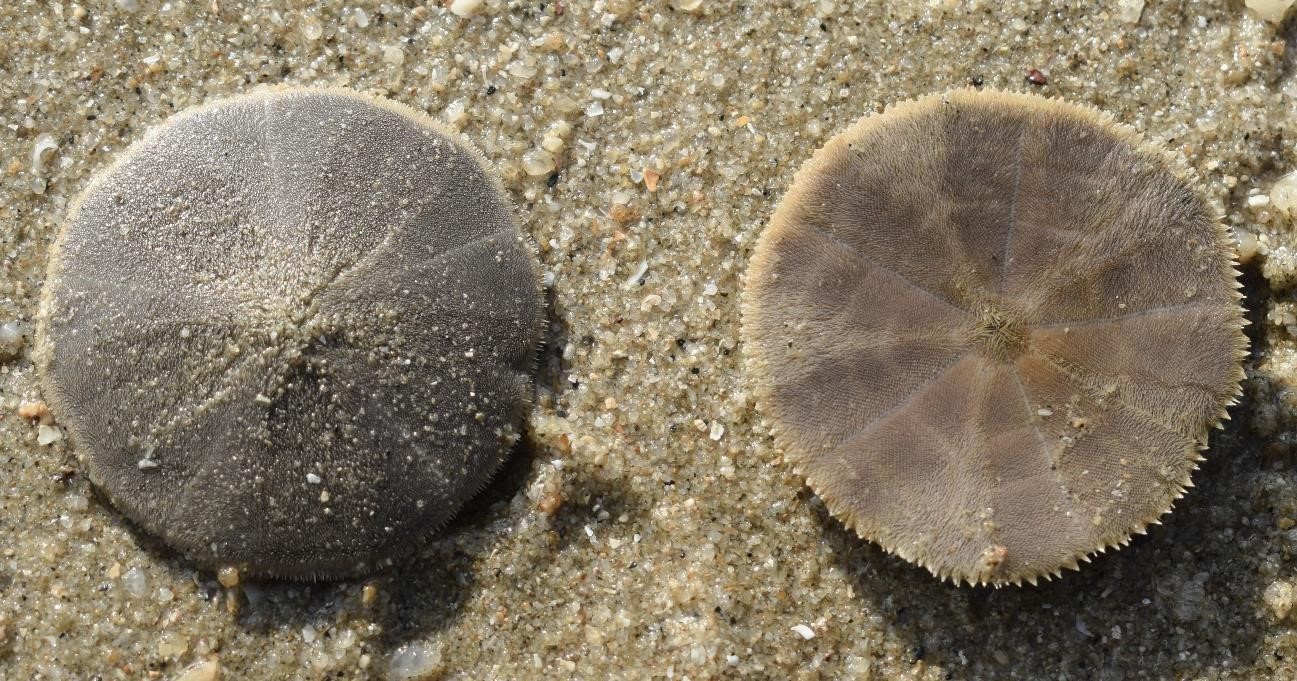 |
| Aboral (left) and oral (right) view of A. placenta on Changi Beach, Singapore (Image by Hannah Yeo, 2016) |
Although colorful when alive, dead sand dollars are equally just as interesting! They may have lost their colour and spines, but every feature can be clearly seen, as labelled in the diagram below. The aboral and oral terms are common when describing echinoderms and refer to the surface opposite the mouth and the side with the mouth respectively
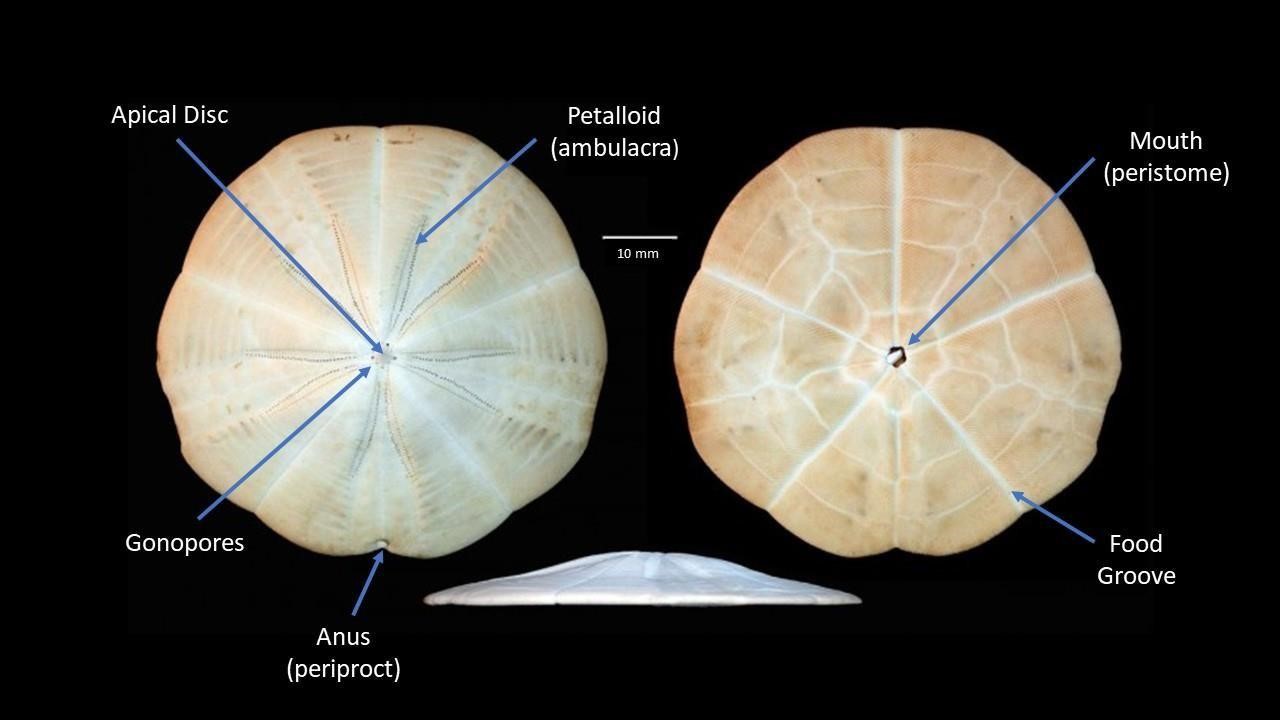 |
| Labelled aboral (left) and oral (right) view of A. placenta (Image taken from WoRMS, and was edited to include labels) [21] (This work is licensed under a Creative Commons) |
The mouth of A. placenta is centrally located on the oral side. The anus is near the test edge, on the aboral surface (side opposite of the mouth) [7] [22]. It has a narrow petaloid that takes up two-thirds of the aboral surface and contains tube feet specialized for gas exchange [7]. The oral surface possesses ambulacral grooves that extend from the test margin to the mouth [22].
Distinguishing between the species
In Singapore, there are a total of four known species of sand dollars in Singapore, all from different genera. Sometimes, you might find other species of sand dollars on our shores. So how do you tell them apart?Generally, the cake sand dollar looks very different from the other three species of sand dollars. In living cake sand dollars, the star or flower shaped pattern is not as obvious as compared to the other three species. A brief guide on how the cake sand dollar can be distinguished from the other species is listed below.
| Species name |
Photo |
Distinguishing features |
| The Cake Sand Dollar (Arachnoides placenta) |
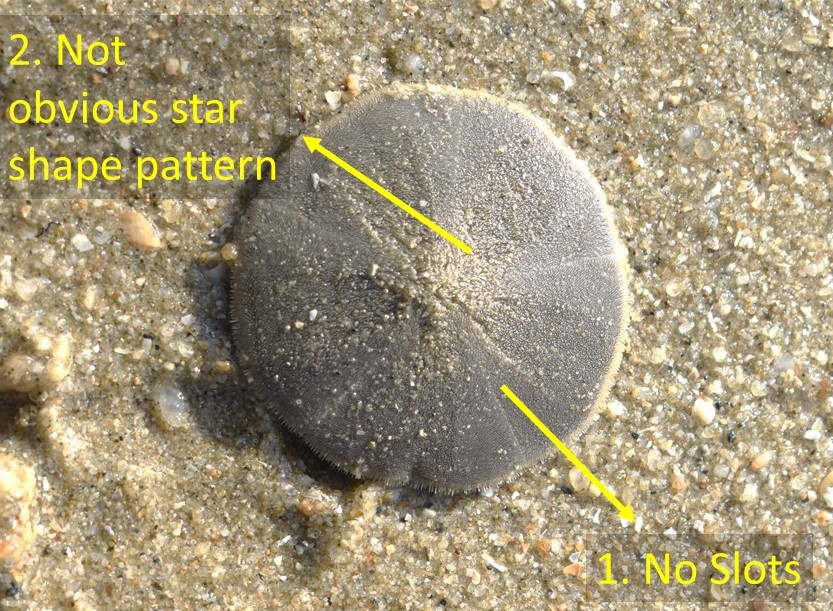 (Image by Hannah Yeo, 2016) |
|
| Keyhole sand dollar [23] (Echinodiscus sp.) |
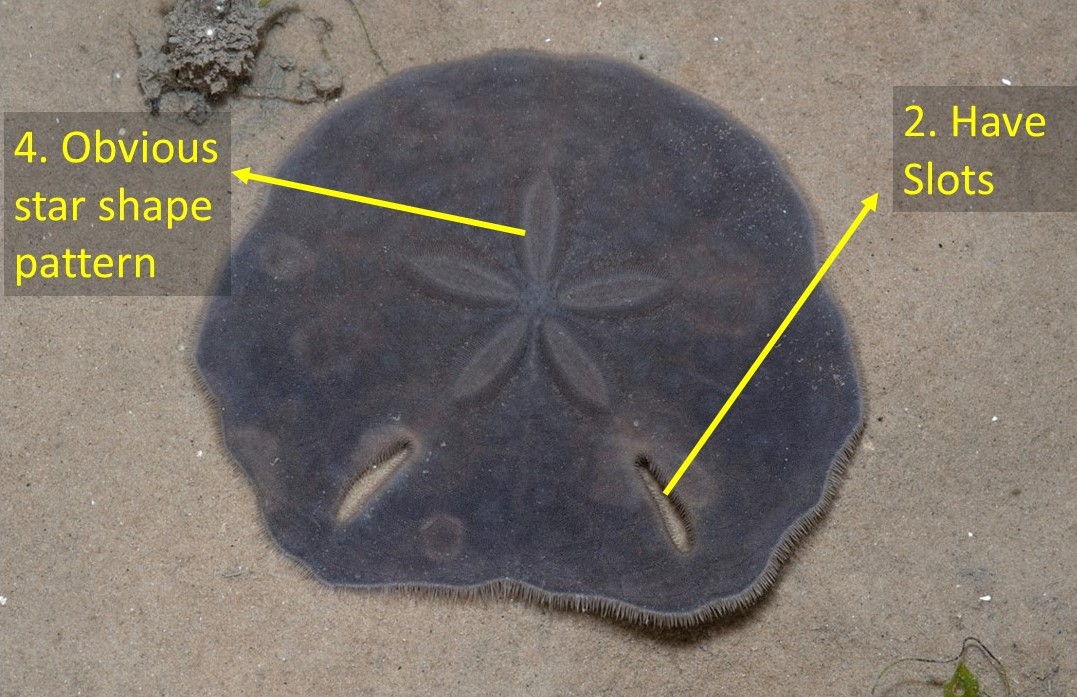 (Image by Ria Tan, 2008) |
|
| Thick-edged sand dollar [24] [25] (Jacksonaster depressum) |
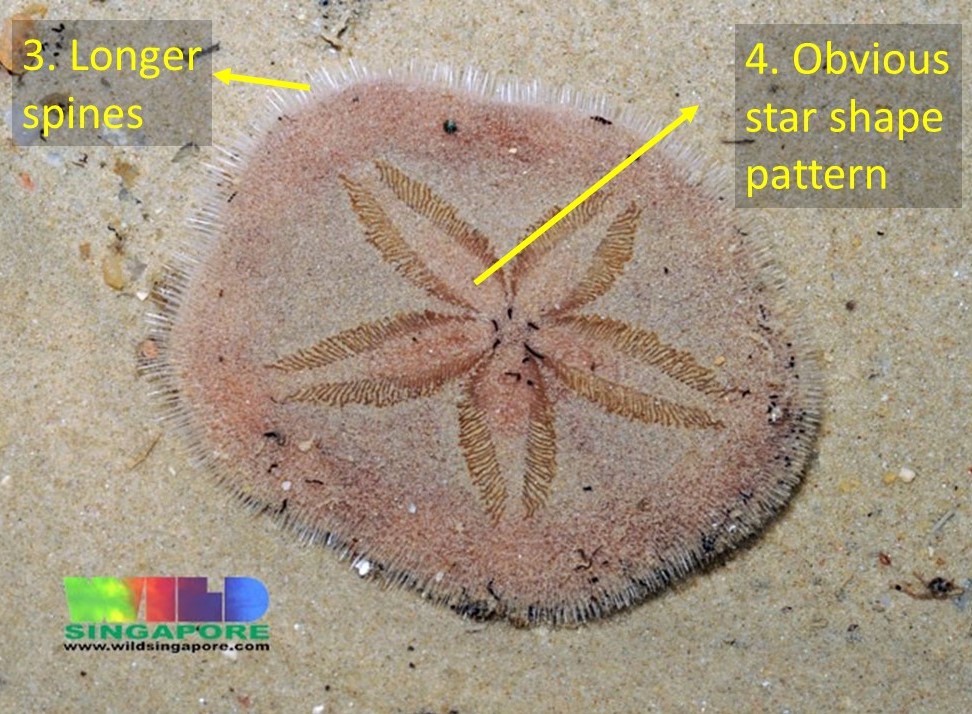 (Image by Ria Tan, 2008) |
|
| Pink sand dollar [24] [26] (Peronella lesueuri) |
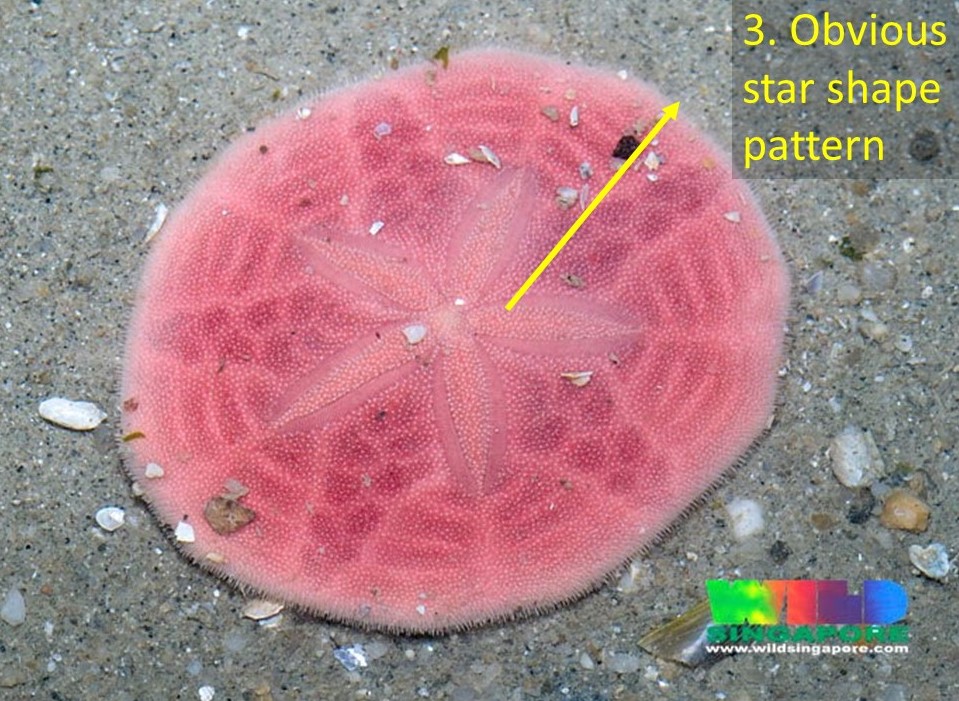 (Image by Ria Tan, 2011) |
|
Physical Characteristics
Size and colour variationThe test diameter increases with age of the sand dollars, meaning smaller ones are younger than those bigger ones. In Singapore, the test diameter of most adult cake sand dollars ranges from 6-8cm [14]. Sometimes juveniles, very small ones (0.6-0.8cm), can be found buried under the sand near groups of larger individuals.
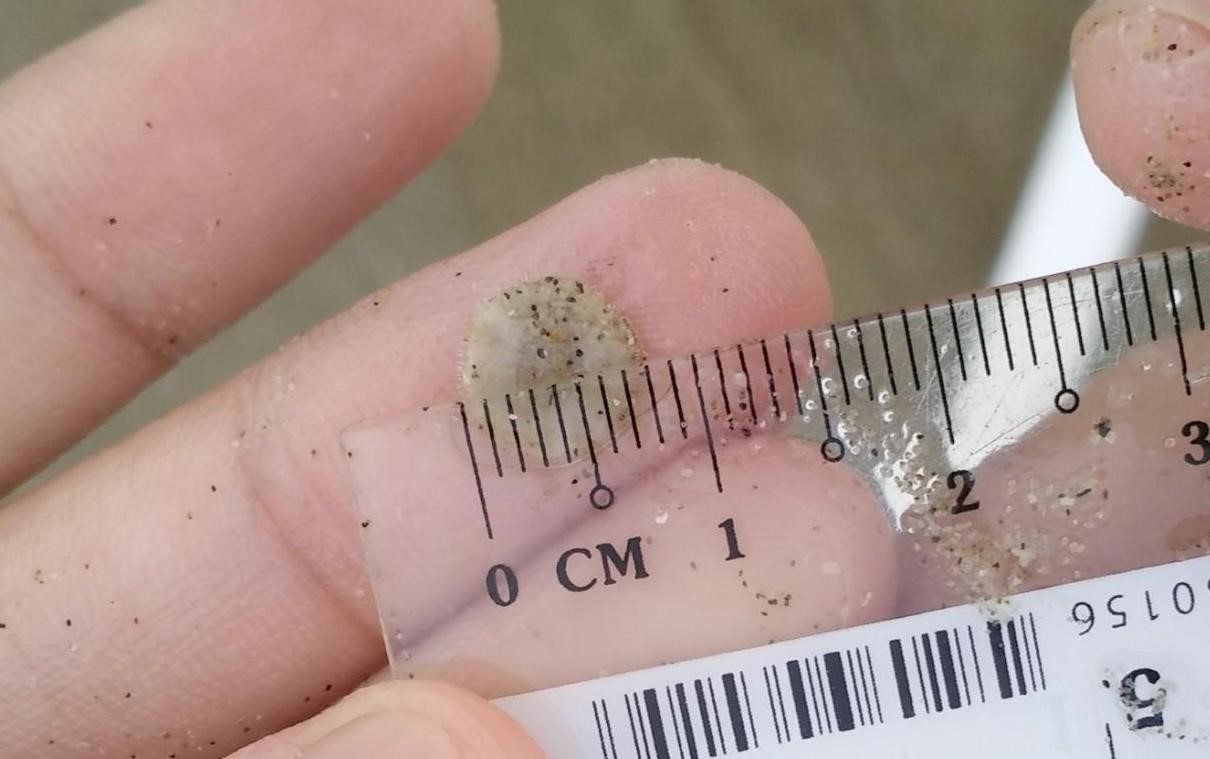 |
| Very small cake sand dollar found amongst larger ones at East Coast Beach (Image by Hannah Yeo, 2016) |
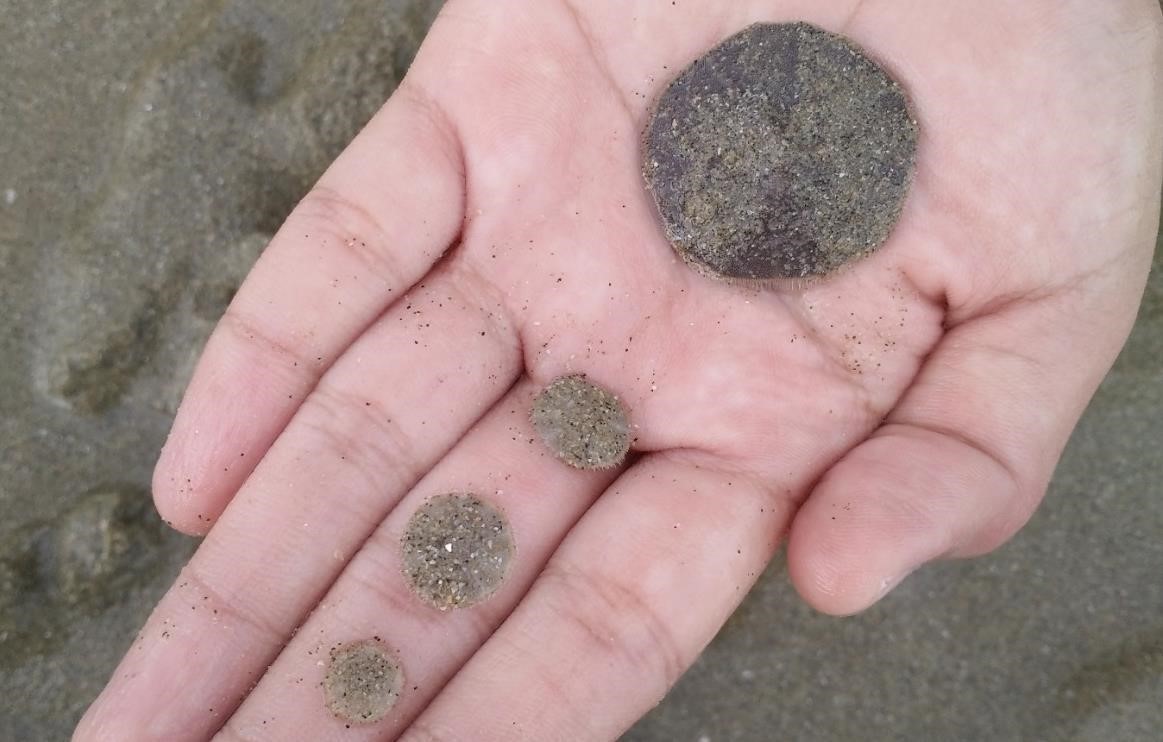 |
| Small to large cake sand dollars on East Coast Beach (Image by Hannah Yeo, 2016) |
Did you notice the colour difference between the smaller sand dollars and the larger ones in the photo above? The juveniles of the cake sand dollars tend to be of a pale beige (sand colour) and progressively changing to a darker purplish-brown colour in adults [7]. The picture below shows a very nice gradual colour progression as the species get bigger. However, little is known/studied on why there this change in colour from juveniles to adults.
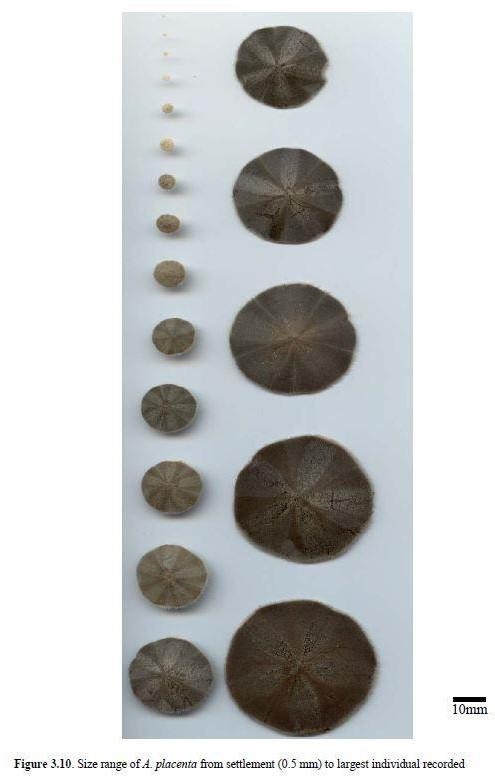 |
| Size and colour progression of A. placenta found in the study by Haycock (2004) [7] |
The Flat Skeleton (test)
Sand dollars are not shells! Unlike snails or mollusks that have a proper shell (external to the body), sand dollars have endoskeletons. This means that the sand dollars hard skeleton lies under its skin and spines and are considered “inside” the animal’s body. This skeleton is known as a test and are made up of calcium carbonate plates [20] [27].
On the inside of the test, it is hollow with a series of buttresses/pillars that passes between the top and bottom surfaces of the test. This helps to strengthen the thin test, allowing for sand dollars to survive the pounding force of the waves [28].
 |
| Series of buttresses in the internal test of sand dollars [28] (Permission pending) [23] |
Biology
Reproduction and life history
The life cycle starts with the release of sperms and eggs in the water column. Eggs are then fertilized in the water column and developed into free-swimming larvae (echinopluteus). They have long arms that are used to capture phytoplankton (small algal cells) in surface waters. For approximately two weeks [15], the larvae goes through several stages of development. These stages can be seen in the video below (Note: the video shows the life cycle of a sea biscuit (Clypeaster subdepressus) larvae, which are closely related to the cake sand dollars).The life of a cycle of a sea biscuit [29]
The larvae settles onto the substratum and metamorphosizes (process of transformation) into juveniles that have the flat skeleton [18]. Over its lifetime, the cake sand dollar will gradually grow in size. A diagram of the life cycle of a typical sea urchin is shown below. Remember how sand dollars are related to sea urchins? [link to urchins to sand dollars]
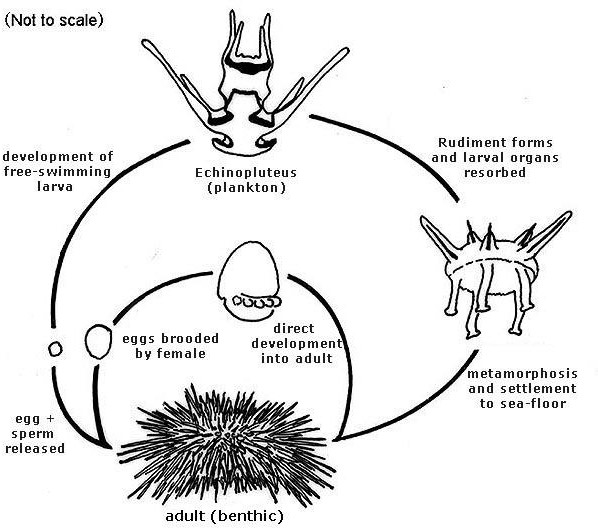 |
| The life cycle of a typical sea urchin [30] |
Feeding mechanism and diet
Like most sand dollars, the cake sand dollar crawls along the shore with their mouth facing the ground, eating microscopic particles on the sediment. Such particles of food include diatoms, blue-green algae and natural bacteria found in sediment [31], in the sediment.However, the cake sand dollar is choosy in terms of the size of its food [18]. Its dense layer of tiny spines keep out larger particles, only allowing the finer ones to move between the small spines and be transported to the mouth and Aristotle’s lantern [link to jaw apparatus]
Ecology
Parasites and predators
In Singapore, some tiny snails from the family, Eulimidae, are believed to be parasites of the cake sand dollar [14]. These snails stick their proboscis (sucking mouthparts) through the skeleton of the sand dollar and feed on the soft tissues and organs inside [32] [33].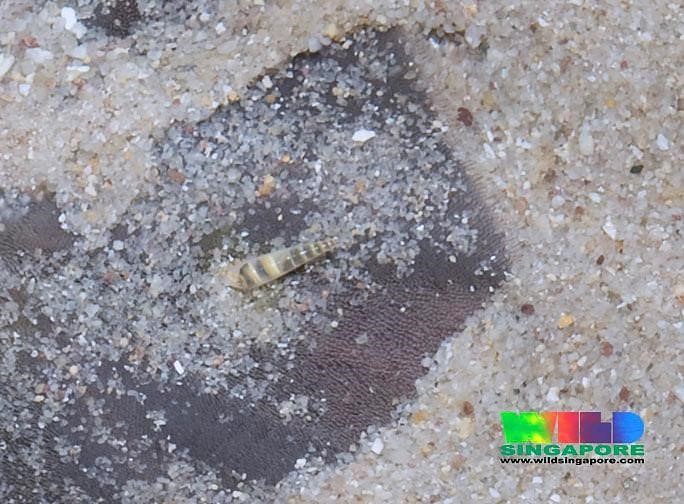 |
| Eulimid snail on A. placenta (Image by Ria Tan, 2011) |
When left exposed during low tides, birds flip them over and peck at their skeleton until they reach the soft tissues inside. They have also been seen eaten by the Knobbly sea star, (Protoreaster nodosus), the Grey bonnet snail (Phalium glaucum), Haddon's carpet anemone (Stichodactyla haddoni) and hermit crabs [14].
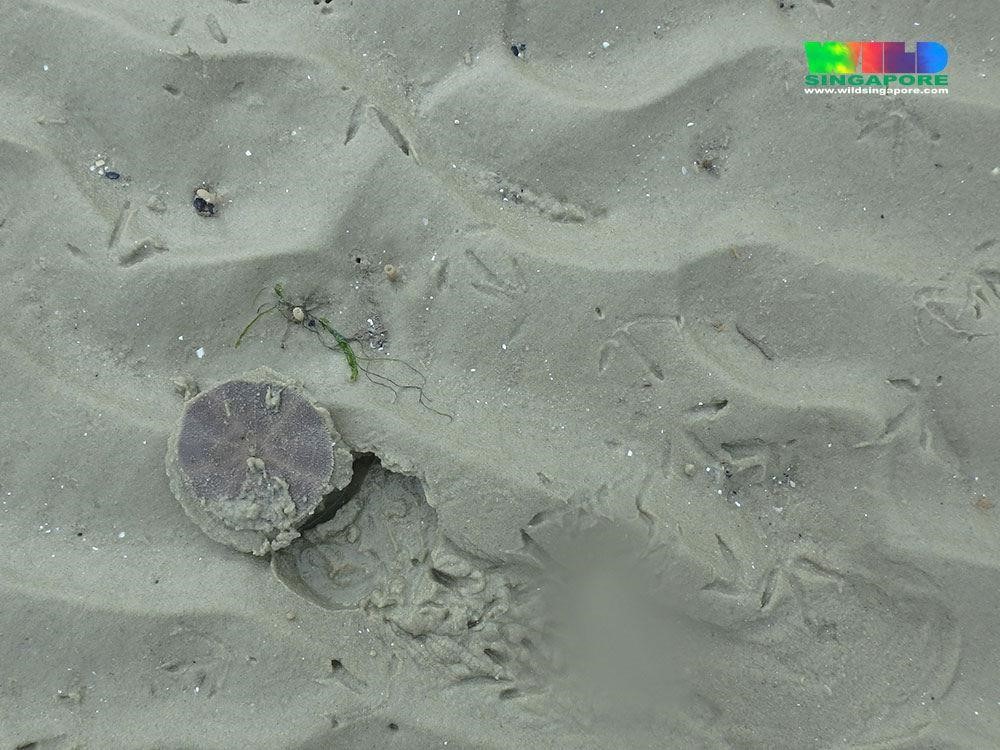 |
| Print left behind by birds around a flipped sand dollar (Image by Ria Tan, 2017) |
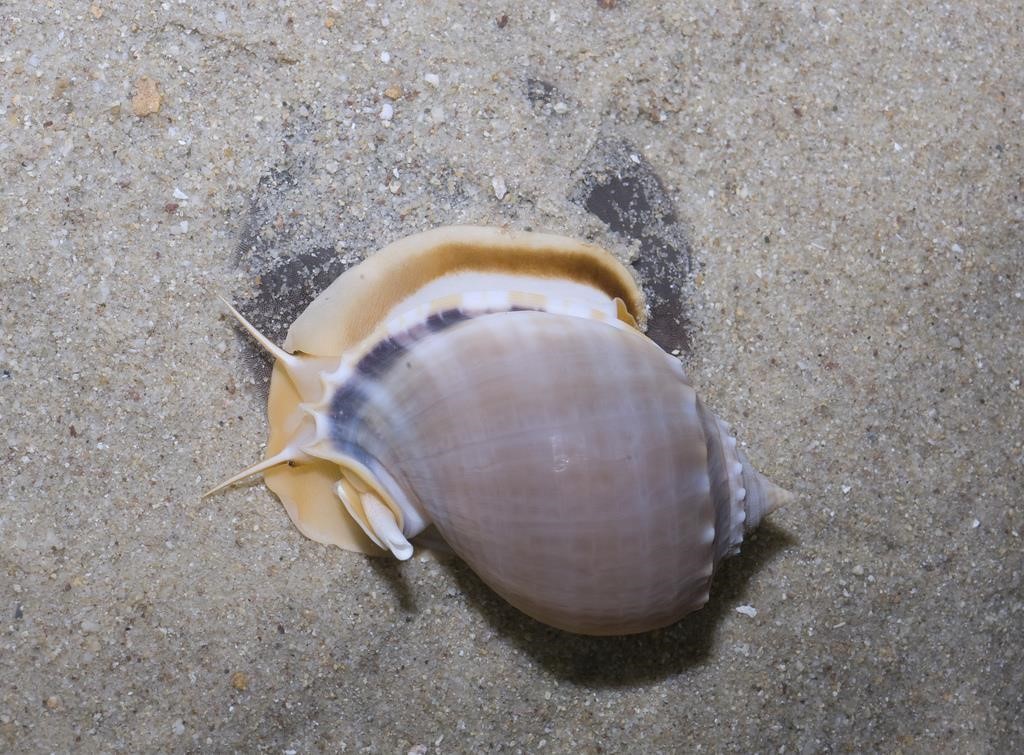 |
| Grey bonnet snail feeding on cake sand dollar (Image by Ria Tan, 2011) |
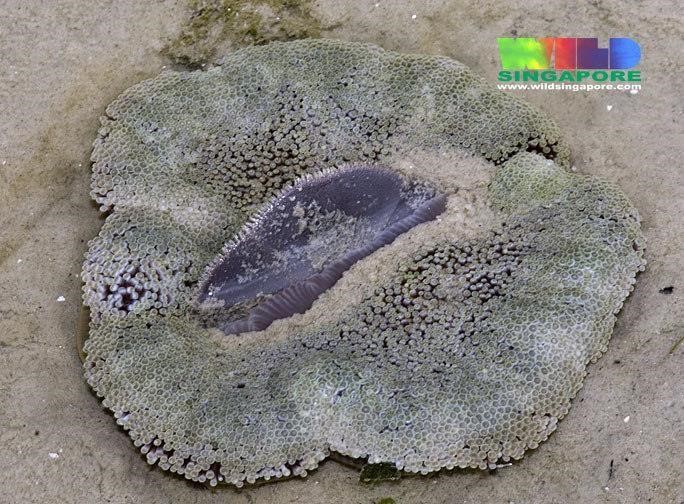 |
| Haddon's carpet anemone eating a cake sand dollar (Image by Ria Tan, 2004) |
Importance and conservation
In certain areas of the shore, the cake sand dollar is one of the most abundant macro-organism on sandy intertidal habitats. Other than being an important food source to other animals, they are important for the environment too. As they feed and burrow, they help to rework the sediments and may churn up nutrients, majorly influencing the physicochemical nature of the coast [34].Threats
Sometimes, the washed up skeleton of dead sand dollars are used to make beautiful art, souvenirs and jewelry such as depicted in the following photo.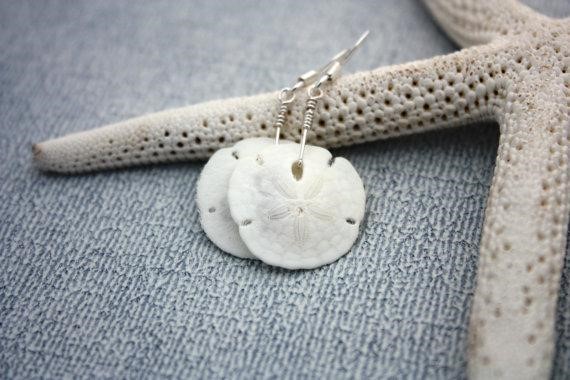 |
| A pair of sand dollar earring by [35] |
However, buying these kinds of crafts are very bad for these animals. Washed up skeletons of sand dollars are usually defective (with holes), and as such, some people harvest the larger sand dollars when they are still alive to make nicer crafts and jewellery [36]. It is advised not to purchase from or support this trade/sale of sand dollars. Sand dollars are important for ecosystem functioning, hence the second rule – do not collect them! Besides, leaving them there helps make our shores a little more interesting and full of wildlife for everyone to enjoy!
Other threats include rising water temperatures [18] [37] and human disturbance. One common disturbance involves mortality from trampling by beachgoers, especially those closer to the surface as they are more likely to break. Therefore, you should always watch your step whenever you visit the intertidal zone.
Indirect threats of human disturbance that the species face include habitat loss and destruction. In response to increasing population size, Singapore has plans to develop the coasts, including the intertidal habitats that support the cake sand dollars (e.g. Chek Jawa and Changi) [38]. Furthermore, coastal development increases sedimentation and pollution within the habitat possibly affecting the survivability of the species.
Status
Like most marine species, there is insufficient information about the cake sand dollar for the IUCN red list conservation to be made [39].Taxonomy
Name
Scientific name: Arachnoides placentaCommon name: Cake Sand Dollar, Cake Urchin
Etymology
The etymology of the genus is made up of a combination of Latin words Arachnid relating to “a spider” or “cobweb” and -oid meaning “like that of”. Together, Arachnoid likely means "cobweb-like” especially of the membrane around the brain and spinal cord [40]. The species name placenta comes from the Latin word meaning “a flat cake” [41]. This could allude to the circular shape (without holes) of the species and series of buttresses within the test that looks like cobweb.Synonyms
In taxonomy, synonyms are names of species that (now) goes by a different name. Sometimes, when there are two people describing the same species, the International Code of Zoological Nomenclature rules that the oldest name takes precedence over others and the rest are recorded as junior synonyms (see below).
The cake sand dollar was originally described by Linnaeus in 1758 and first listed in Systema Naturae as Echinus placenta as shown below.
 |
| The original description of A. placenta (listed as Echinus placenta) [42] |
Subsequently, the name of the species has changed multiple times due to reclassification and is now known as Arachnoides placenta today.
List of Synonyms [21]
Echinus placenta Linnaeus, 1758Echinarachnius placenta (Linnaeus, 1758)
Scutella placenta (Linnaeus, 1758)
Scutella rumphii Blainville, 1827 (junior synonyms)
DNA Barcode
 |
| Arachnoides placenta COI-5P code (From BOLD [43]) |
Phylogeny
Classification
While there have been some cladistic analyses that have focused on various Orders within the Class: Echinoidea (such as Clypeasteroida), there have yet to be any phylogenetic studies done on the Arachnoides species within the Family Clypeasteridae. This could be due to the lack of primary data for constructing taxon-character data matrix (i.e. plating pattern, lantern and girdle structure) [44].It is interesting to note that previous classification placed the species in the genus Echinarachnius and Scutella (indicated by dotted arrows) which are not closely related to Arachnoides (indicated by bold arrow). However, the relationships for Echinarachnius and Scutella have small bootstrap support (less than 20), possibly due to lack of data.
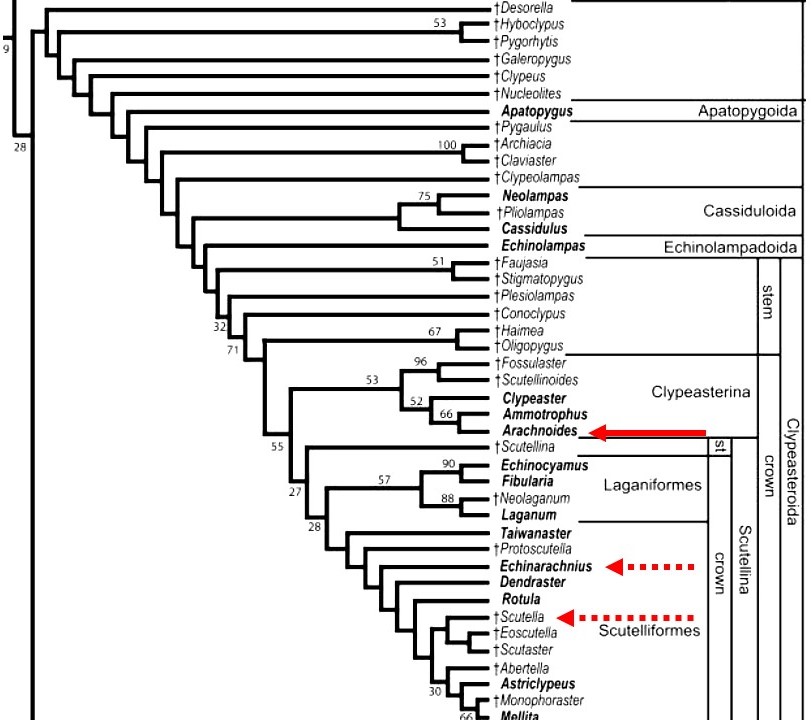 |
| Parsimony phylogenetic analysis in TNT and PAUP. Bootstrap values are based on 100,000 fast heuristic searches, excluding any value below 20. Diagram from [44]. |
Furthermore, studies that have constructed phylogenetic trees of major clades in the Order Clypeasteroida tend to have little agreement in the relationships between orders and families. For instance, phylogenetic trees constructed using morphological character states from fossils and extant taxa differed from trees constructed using molecular data or trees just using extant taxa. This can be seen, in two constructed trees from Kroh and Smith (2010) [44].
Comparison of phylogenetic trees generated from morphology and molecular data gave rise to differences in the relationships between Clypeasterines, Scutellines and Cassiduloids. This mismatch could be due to the small taxon selection used in molecular analysis and/or because sequences available online are usually represented by one specimen from just one region within its full species distribution. As such, much more work on the phylogenetic tree of Clypeasteroida needs to be done to resolve the disagreements in relationship with other orders.
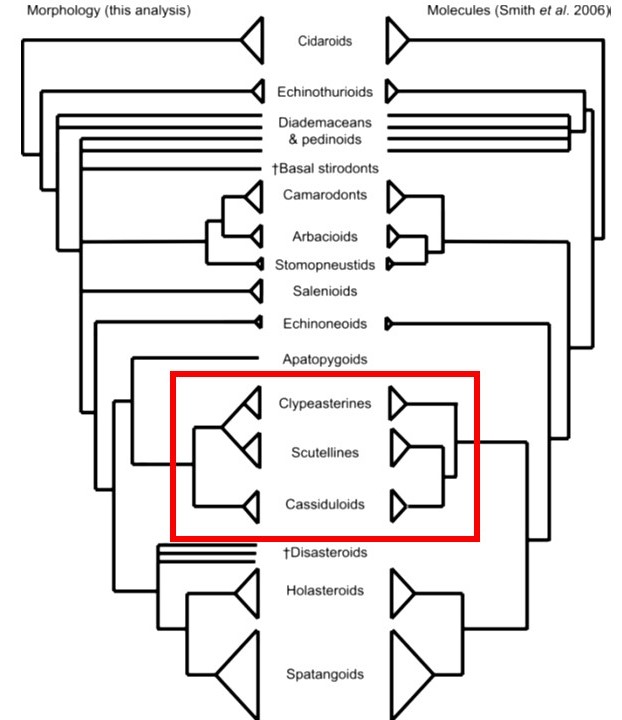 |
| Figure 4. from Kroh and Smith (2010) showing a simplified phylogenetic tree based on morphology and molecular sequence data [44] [49]. |
Literature and References
1. “How much is a sand dollar worth?”, by Wonderopolis. National Center for Families Learning (14 Jan 2013). URL:https://wonderopolis.org/wonder/how-much-is-a-sand-dollar-worth (accessed on 30 Nov 2017).
2. Hines, J. & Kenny, R., 1967. The growth of Arachnoides placenta (L.) (Echinoidea). Pacific Science 21(1): 230-235.
3. “Watch a sand dollar burry itself!” by Monterey Bay Aquarium YouTube Channel, 25 Aug 2016. URL:https://www.youtube.com/watch?v=848pA7OvJzk (accessed on 22 Nov 2017).
4. “Marine Life Series: Sand Dollars”, by Mark H, Daily Kos, Kos Media (2 Feb 2008). URL:https://www.dailykos.com/stories/2008/2/1/448004/- (accessed on 22 Nov 2017).
5. Hardy, A. R. & Merz, R. A., 2013. Inverted sand dollars actively orient themselves in flow to increase likelihood of righting. Invertebrate Biology 132(1): 52-61.
6. “What (and How) do Sea Urchins Eat? Sea Urchin Feeding Roundup!”, by Chris M, The Echinoblog (9 Jul 2013). URL:http://echinoblog.blogspot.sg/2013/07/what-and-how-do-sea-urchins-eat-sea.html (accessed on 17 Nov 2017).
7. Haycock, L. J., 2004. The Reproduction and Recruitment of the sand dollar Arachnoides placenta (L.) (Echinoidea: Echinodermata) from differing habitats on the North Queensland coast. M.SC. Thesis, School of Marine Biology and Aquaculture, James Cook University, Townsville, Queensland, Australia.
8. “My star of sand dollar doves”, by Keri Fabin, Fabin Bros. Farms (10 May 2011). URL:http://kerimehome.blogspot.sg/2011/10/my-star-of-sand-dollar-doves.html (accessed on 29 Oct 2017).
9. “5 "Doves" escaping from inside a Sand Dollar”, by photoholic1. Flickr, 31 Aug 2009. URL:https://www.flickr.com/photos/lenbo/3920415711 (accessed on 29 Oct 2017).
10. “Sand Dollars ARE Sea Urchins. Please make a note of it!”, by Chris M, The Echinoblog (13 Mar 2012). URL:http://echinoblog.blogspot.sg/2012/03/sand-dollars-are-sea-urchins-please.html (accessed on 17 Nov 2017).
11. Schultz, H. A. G., 2017. Echinoidea: with bilateral symmetry. Irregularia. Walter de Gruyter GmbH & Co KG. Berlin, Germany. 367 pp.
12. “Arachnoides placenta (Linnaeus, 1758)”, by Global Biodiversity Information Facility (GBIF). GBIF Backbone Taxonomy. Checklist Dataset. URL:https://www.gbif.org/species/4875329 (accessed on 25 Oct 2017).
13. “Global administrative areas (GADM)”, by R. Hijmans (30 Aug 2009). URL:http://gadm.org/ (accessed on 30 Nov 2017).
14. “Cake sand dollar Arachnoides placenta Family Clypeasteridae”, by Ria Tan, Wild Singapore (6 Mar 2010). URL:http://www.wildsingapore.com/wildfacts/echinodermata/echinoidea/sandollar/arachnoides.htm (accessed on 11 Nov 2017).
15. Chen, C. -P. & Chen, B., -Y., 1992. Effects of high temperature on larval development and metamorphosis of Arachnoides placenta (Echinodermata: Echinoidea). Marine Biology 112(1):445-449.
16. Campbell, E., 1995. Population structure, predation and recruitment patterns in the tropical sand dollar: Arachnoides placenta (L.). B.SC. Thesis, Department of Marine Biology and Aquaculture, James Cook University, Townsville, Queensland, Australia.
17. Koizumi, N., 1997. Population study and biological aspect of Arachnoides placenta (L.) at Pallarenda Beach and Rowes bay. Thesis (BSc Honours), Department of Marine Biology, James Cook University of North Queensland.
18. Aung, W. (1975). Observations on the reproductive biology of the tropical sand dollar Arachnoides placenta (L.) (Echinodermata: Echinoidea). M.Sc. Thesis Department of Marine Biology, James Cook University, Townsville, Queensland Australia. 141 pp.
19. O’Hara, T. & Byrne, M., 2017. Australian Echinoderms: Biology, Ecology and Evolution. Csiro Publishing. Clayton, Australia. 624pp.
20. “Sand Dollars Order Clypeasteroida”, by Ria Tan, Wild Singapore (11 Apr 2009). URL:http://www.wildsingapore.com/wildfacts/echinodermata/echinoidea/sandollar/sandollar.htm (accessed on 11 Nov 2017).
21. “Arachnoides placenta (Linnaeus, 1758)”, by World Register of Marine Species (WORMS) (9 Mar 2014). URL:http://www.marinespecies.org/aphia.php?p=taxdetails&id=513113 (accessed on 25 Oct 2017).
22. Chao, S. -M., The Irregular Sea Urchins (Echinodermata: Echinoidea) from Taiwan, with Descriptions of Six New Records, 2000. Zoological Studies 39(3):250-265.
23. “Keyhole Sand Dollar Echinodiscus sp. Family Astriclypeidae”, by Ria Tan, Wild Singapore (13 Apr 2009). URL:http://www.wildsingapore.com/wildfacts/echinodermata/echinoidea/sandollar/echinodiscus.htm (accessed on 25 Oct 2017).
24. “Jacksonaster Lambert in Lambert & Thiery, 1914, p. 313”, by The Echinoid Directory, Natural History Museum, London (21 Apr 1997). URL:http://www.nhm.ac.uk/our-science/data/echinoid-directory/taxa/taxon.jsp?id=791 (accessed on 12 Oct 2017).
25. “Thick-edged sand dollar Jacksonaster depressum Family Laganidae”, by Ria Tan, Wild Singapore (8 May 2015). URL:http://www.wildsingapore.com/wildfacts/echinodermata/echinoidea/sandollar/depressum.htm (accessed on 11 Nov 2017).
26. “Sand Dollars Order Clypeasteroida”, by Ria Tan, Wild Singapore (11 Apr 2009). URL:http://www.wildsingapore.com/wildfacts/echinodermata/echinoidea/sandollar/sandollar.htm (accessed on 11 Nov 2017).
27. Chia, F. -S., 1977. Structure and function of the genital papillae in a tropical sand dollar, arachnoides placenta (L.) with a discussion on the adaptive significance of genital papillae in echinoids. Journal of Experimental Marine Biology and Ecology 27(2):187-194.
28. “Internal buttressing”, by The Echinoid Directory, Natural History Museum, London (8 May 2015). URL:http://www.nhm.ac.uk/our-science/data/echinoid-directory/morphology/dollars/buttressing.html (accessed on 12 Oct 2017).
29. “A Sea Biscuit’s Life”, by Bruno C. Vellutini YouTube Channel, 5 Nov 2008. URL:https://www.youtube.com/watch?v=KeIvSE5S2yQ (accessed on 2 Oct 2017).
30. “Reproduction and life history”, by The Echinoid Directory, Natural History Museum, London (17 Oct 2015). URL:http://www.nhm.ac.uk/our-science/data/echinoid-directory/intro/reproduction.html (accessed on 8 Oct 2017).
31. Meadows, P. S. & Campbell, J. I., 1972. Habitat Selection in Aquatic Invertebrates. Advances in Marine Biology 10(1):271-382.
32. Crossland, M. R., Alford, R. A. & Collins, J. D., 1991. Population dynamics of an ectoparasitic gastropod, Hypermastus sp. (Eulimidae), on the sand dollar, Arachnoides placenta (Echinoidea). Australian Journal of Marine and Freshwater Research 42(1):69-76.
33. Crossland, M. R., Collins, J. D. & Alford, R. A., 1993. Host selection and distribution of Hypermastus placentae (Eulimidae), an ectoparasitic gastropod on the sand dollar Arachnoides placenta (Echinoidea). Australian Journal of Marine and Freshwater Research 44(1):835-844.
34. Salsman, G. G. & Tolbert, W. H., 1965. Observations on the sand dollar Mellita quinquiesperforata. Limnology and Oceonography 10(1):152-155.
35. “Sand Dollar Earrings, White Sand Dollar Jewelry Beach Jewelry, Nautical Earrings Nautical Jewelry Hawaiian Jewelry Hawaii Jewelry Ocean O22”, by Kari, DRaeDesigns, featured on Etsy.com (1 Jan 2017). URL:https://www.etsy.com/sg-en/listing/218559609/sand-dollar-earrings-white-sand-dollar?ga_order=most_relevant&ga_search_type=all&ga_view_type=gallery&ga_search_qu (accessed on 3 Sep 2017).
36. “For nature guides: introducing sand dollars and sea urchins”, by Ria Tan, Wild Singapore (27 Aug 2009). URL:http://www.wildsingapore.com/wildfacts/echinodermata/fngechinoidea.htm (accessed on (11 Nov 2017).
37. Lane, J. E. M. & Lawrence, J. M., 1980. Seasonal Variation in Body Growth, Density and Distribution of a Population of Sand Dollars, Mellita Quinquiesperforata (Leske). Bulletin of Marine Science 30(4):871-882.
38. “What shores will Singapore lose in 7-million population plan”, by Ria Tan, Wild Shores of Singapore blog (17 May 2013). URL:http://wildshores.blogspot.sg/2013/01/what-shores-will-singapore-lose-in-7.html#.WiQND0qWbb1 (accessed on 12 Oct 2017).
39. “Arachnoides placenta (Linnaeus, 1758) cake sand dollar”, by Sea Life Base (9 May 2017). URL:http://www.sealifebase.org/Summary/speciesSummary.php?ID=2381388&genusname=Arachnoides&speciesname=placenta (accessed on 27 Oct 2017).
40. “arachnoid (adj.)”, by Online Etymology Dictionary (1 Jan 2001). URL:https://www.etymonline.com/word/arachnoid (accessed on 2 Oct 2017).
41. “placenta (n.)”, by Online Etymology Dictionary (1 Jan 2001). URL:http://www.etymonline.com/word/placenta (accessed on 2 Oct 2017).
42. Linnaeus, C., 1758. Systema naturae per regna tria naturae :secundum classes, ordines, genera, species, cum characteribus, differentiis, synonymis, locis. Holmiae : Impensis Direct. Laurentii Salvii, 1758-1759 (7 Apr 2008). URL:https://doi.org/10.5962/bhl.title.542 (accessed on 10 Oct 2017).
43. “Public Data Portal – Specimen Record. Record Details for ECLI035-08”, by Bold Systems (1 Jan 2014). URL:http://www.boldsystems.org/index.php/Public_RecordView?processid=ECLI035-08 (accessed on 20 Oct 2017).
44. Kroh, A. & Smith, A. B., 2010. The phylogeny and classification of post-Palaeozoic echinoids. Journal of Systematic Paleontology 8, 2010: Issue 2.
45. Smith, A. B., Pisani, D., Mackenzie-Dodds, J. A., Stockley, B., Webster, B. L. & Littlewood, D. T. J. 2006. Testing the molecular clock: molecular and paleontological estimates of divergence times in the Echinoidea (Echinodermata). Molecular Biology and Evolution, 23, 1832–1851